Related Research Articles

Dōgen Zenji, was a Japanese Zen Buddhist monk, writer, poet, philosopher, and founder of the Sōtō school of Zen in Japan. He is also known as Dōgen Kigen (道元希玄), Eihei Dōgen (永平道元), Kōso Jōyō Daishi (高祖承陽大師), and Busshō Dentō Kokushi (仏性伝東国師).
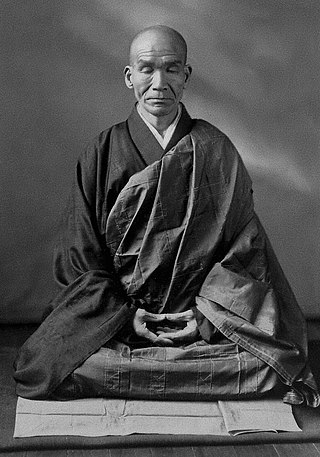
Zazen is a meditative discipline that is typically the primary practice of the Zen Buddhist tradition.

Sōtō Zen or the Sōtō school is the largest of the three traditional sects of Zen in Japanese Buddhism. It is the Japanese line of the Chinese Cáodòng school, which was founded during the Tang dynasty by Dòngshān Liánjiè. It emphasizes Shikantaza, meditation with no objects, anchors, or content. The meditator strives to be aware of the stream of thoughts, allowing them to arise and pass away without interference.

John Daido Loori was a Zen Buddhist rōshi who served as the abbot of Zen Mountain Monastery and was the founder of the Mountains and Rivers Order and CEO of Dharma Communications. Daido Loori received shiho from Taizan Maezumi in 1986 and also received a Dendo Kyoshi certificate formally from the Soto school of Japan in 1994. In 1997, he received dharma transmission in the Harada-Yasutani and Inzan lineages of Rinzai Zen as well. In 1996 he gave dharma transmission to his student Bonnie Myotai Treace, in 1997 to Geoffrey Shugen Arnold, and in 2009 to Konrad Ryushin Marchaj. In addition to his role as a Zen Buddhist priest, Loori was an exhibited photographer and author of more than twenty books and was an avid naturalist.

Zen Mountain Monastery is a Zen Buddhist monastery and training center on a 220-acre (0.89 km2) forested property in the Catskill Mountains in Mount Tremper, New York. It was founded in 1980 by John Daido Loori originally as the Zen Arts Center. It combines the Rinzai and Sōtō Zen traditions, in both of which Loori received Dharma transmission. Loori's first dharma heir was Bonnie Myotai Treace, Sensei, who received shiho, or dharma transmission, from him in 1996. From Loori's death in October 2009 until January 2015, Zen Mountain Monastery had two teachers: Geoffrey Shugen Arnold and Konrad Ryushin Marchaj, who received Dharma transmission from Loori in 1997 and 2009, respectively. Since January 2015, the training at the Monastery has been led by Shugen Roshi, assisted by Ron Hogen Green, Sensei; Jody Hojin Kimmel, Sensei; and Vanessa Zuisei Goddard, Sensei.

Dennis Merzel is an American Zen and spirituality teacher, also known as Genpo Roshi.

Japanese Zen refers to the Japanese forms of Zen Buddhism, an originally Chinese Mahāyāna school of Buddhism that strongly emphasizes dhyāna, the meditative training of awareness and equanimity. This practice, according to Zen proponents, gives insight into one's true nature, or the emptiness of inherent existence, which opens the way to a liberated way of living.

Bernie Glassman was an American Zen Buddhist roshi and founder of the Zen Peacemakers, an organization established in 1980. In 1996, he co-founded the Zen Peacemaker Order with his late wife Sandra Jishu Holmes. Glassman was a Dharma successor of the late Taizan Maezumi-roshi, and gave inka and Dharma transmission to several people.

Hakuun Yasutani was a Sōtō priest and the founder of the Sanbo Kyodan, a lay Japanese Zen group. Through his students Philip Kapleau and Taizan Maezumi, Yasutani has been one of the principal forces in founding western (lay) Zen-practice.
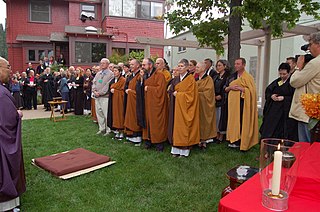
White Plum Asanga, sometimes termed White Plum Sangha, is a loose "organization of peers whose members are leaders of Zen Communities in the lineage of Hakuyu Taizan Maezumi," created by Hakuyu Taizan Maezumi and Tetsugen Bernard Glassman. It consists of Maezumi's Dharma heirs and subsequent successors.
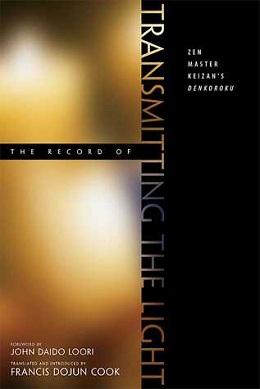
Denkōroku is a kōan collection written in 1300 by Keizan Jokin Zenji, the Great Patriarch of Sōtō Zen Buddhism, based on approximately a year of his Dharma talks.
Below is a timeline of important events regarding Zen Buddhism in the United States. Dates with "?" are approximate.
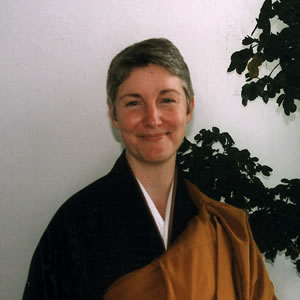
Bonnie Myotai Treace is a Zen teacher and priest, the founder of Hermitage Heart, and formerly the abbot of the Zen Center of New York City (ZCNYC). She teaches currently in Black Mountain and Asheville, North Carolina. Myotai Sensei is the first Dharma successor of John Daido Loori, Roshi, in the Mountains and Rivers Order (MRO), having received shiho, dharma transmission, from him in 1996. Serving and training for over two decades in the MRO, she was the establishing teacher and first abbess of the ZCNYC. At the Monastery she was the Vice Abbot, the first director of Dharma Communications, editor of Mountain Record, and coordinator of the affiliates of the MRO. Treace, ordained as a Zen monastic, now lives as a lay teacher, working primarily with her long-term students.
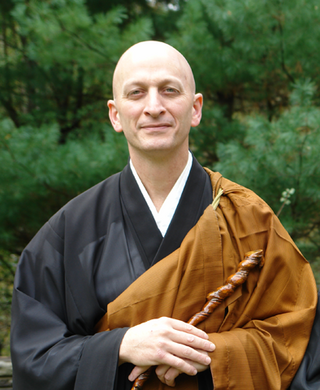
Geoffrey Shugen Arnold is Rōshi of the Mountains and Rivers Order (MRO) founded by John Daido Loori, from whom Shugen received shiho, or dharma transmission, in July 1997. As a lineage holder in the Sōtō tradition, Shugen currently serves as head of MRO and abbot of Zen Mountain Monastery in Mt. Tremper, New York, where he serves as the full-time resident teacher. Trained as a musician, Shugen was introduced to and began practicing Zen meditation in 1975. He began his formal training at Zen Mountain Monastery in 1984, and received tokudo, full monastic ordination, in 1988. Shugen's teachings have appeared in various Buddhist publications, including Buddhadharma: The Practitioner's Quarterly, The Mountain Record and in The Best Buddhist Writing 2005 and 2009. He is the author of O, Beautiful End, a collection of Zen memorial poems, published by Dharma Communications in 2012.

Taigen Dan Leighton is a Sōtō priest and teacher, academic, and author. He is an authorized lineage holder and Zen teacher in the tradition of Shunryū Suzuki and is the founder and Guiding Teacher of Ancient Dragon Zen Gate in Chicago, Illinois. Leighton is also an authorized teacher in the Japanese Sōtō School (kyōshi).

Konrad Ryushin Marchaj

So'tekizan Korinji (祖的山光林寺), or simply Korinji, is a Rinzai Zen Buddhist monastery (sodo) near Reedsburg, Wisconsin, United States. It opened in 2017. The monastery is additionally a center for Shingon and Shugendo practice, and houses the Korinji Center for the Contemplative Arts.

Dō. It is very often used in Japanese Buddhism as a suffix in the name of some of the many buildings that can be part of a Japanese temple compound. The suffix can be the name of a deity associated with it or express the building's function within the temple's compound.
Zen was introduced in the United States at the end of the 19th century by Japanese teachers who went to America to serve groups of Japanese immigrants and become acquainted with the American culture. After World War II, interest from non-Asian Americans grew rapidly. This resulted in the commencement of an indigenous American Zen tradition which also influences the larger western (Zen) world.
Zen lineage charts depict the transmission of the dharma from one generation to another. They developed during the Tang dynasty, incorporating elements from Indian Buddhism and East Asian Mahayana Buddhism, but were first published at the end of the Tang.
References
- 1 2 "About Mountains and Rivers Order". Zen Mountain Monastery. ZMM.org. Retrieved 23 March 2024.
- ↑ Mountains and Rivers Order website
- ↑ Zen Mountain Monastery website
- 1 2 Sunday Chanting Service on Zen Mountain Monastery Website